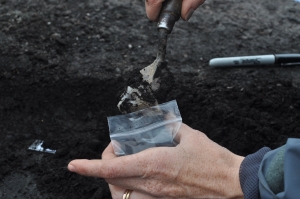
The experimental tools were buried on 19 May 2014. After 1 month, on 16 June 2014, the first set of tools (Groups 1, 3, and 5) were recovered. While the intention had been to bury the tools from the second set (Groups 2, 4, and 6) for one year, a change in the excavation schedule led us to recover these tools after 11 months of burial, on 21 April 2015.
The flakes were excavated with trowels following standard residue collection protocols used at Star Carr. During recovery in the units, flakes and their labels were still in close proximity to each other, even after the 11 month period (Figure 7). Flakes were removed by inserting the trowel below the flake and levering it out directly into a new plastic zip-lock bag (Figure 8). Retrieval methods were rigorous, with care taken to ensure that hands did not touch the flakes at any time. Associated soil samples were taken directly below each flake and placed in new zip-lock bags. The samples were delivered to a refrigerator on the same day, where they remained in cold storage prior to microscopic analysis.


At the time of recovery, the pH value of the soil in each unit was recorded, in the manner described above. Table 4 presents the average pH values for each unit recorded throughout the experiment. The pH values in unit 1 on the dry land at Star Carr were consistently slightly acidic; unit 3 at Manor Farm was consistently alkaline at all burial and collection points. The values obtained in the wetland unit 2 at Star Carr require some explanation. A major decrease in acidity was noted between the pH values taken at the the time of burial and at the 11 months recovery point. As with all units, the wetland unit was covered with the original soil excavated to make the pit, but several metres of backfill were added on top of the unit at the close of the excavation season. This backfill contained alkaline calcium-rich marl and also possibly high pH fertilisers from the topsoil. Percolation of water through the backfilled soil could have mobilised higher pH components down to the surface of unit 2 and thus explain the higher pH values obtained after 11 months. Despite these elevated pH values, unit 2 still remained acidic throughout the duration of the experiment.
| At time of burial | At 1 month recovery | At 11 months recovery | |
|---|---|---|---|
| Star Carr Unit 1 | 6.12 | 6.53 | 6.65 |
| Star Carr Unit 2 | 2.43 | 2.86 | 4.52 |
| Manor Farm Unit 3 | 8.59 | 8.25 | 8.38 |
Internet Archaeology is an open access journal based in the Department of Archaeology, University of York. Except where otherwise noted, content from this work may be used under the terms of the Creative Commons Attribution 3.0 (CC BY) Unported licence, which permits unrestricted use, distribution, and reproduction in any medium, provided that attribution to the author(s), the title of the work, the Internet Archaeology journal and the relevant URL/DOI are given.
Terms and Conditions | Legal Statements | Privacy Policy | Cookies Policy | Citing Internet Archaeology
Internet Archaeology content is preserved for the long term with the Archaeology Data Service. Help sustain and support open access publication by donating to our Open Access Archaeology Fund.